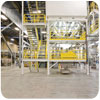
By piggybacking roasters and fillers, packaging and roasting operators are in close proximity, minimizing communications problems and improving product flow. Source: Stellar Inc.
For manufacturers blessed with growing sales, new facilities become continuous-improvement exercises, an opportunity to fine-tune the last plant’s systems and come up with something better. For Seattle-based Starbucks Coffee Co., the only thing stronger than its brew was the sales growth over the last 20 years, resulting in several improvement opportunities.
Roasting was viewed as an art at Starbucks until the early 1990s, when the company built its first modern roasting facility in Kent, WA. A second plant followed in 1994 in York, PA, with another greenfield coming on line in Carson Valley, NV, in 2003. A scaled down facility was built in Amsterdam, the Netherlands, the same year.
Despite growing capacity, manufacturing was hard pressed to keep up with demand from retail distribution and Starbucks’ own stores. By 2006, engineers and operations managers began the site selection and planning process for the network’s fifth roasting plant. Unlike the earlier projects, which were designed for gradual expansion to meet demand, the new roasting plant would be fully equipped and ready to fill orders on demand to a streamlined supply chain.
The Starbucks plant-development timeline mirrors the general food manufacturing shift from mega-plants serving broad geographic areas to more nimble regional facilities that expedite inventory flow and optimize product freshness and quality. Fifteen years ago, Starbucks managers envisioned million-square-foot facilities, but those plans faded as greater attention was paid to the true cost of transportation. Growing interest in reducing greenhouse gases may be the final nail in the mega-plant’s coffin. “Shipping product from Nevada or Pennsylvania to a DC that then distributes it to Florida or Texas results in a lot of emissions,” allows Brent Denniston, Starbucks’ vice president of manufacturing, engineering and quality. “Regionalizing our production is a big part of a very successful story.”
The global financial implosion began two months before the first burlap sacks of green beans at Starbuck’s new Sandy Run, SC, plant were roasted and packed November 14, 2008, triggering a corporate retrenchment. Nonetheless, the engineering team and its partners delivered a gold-certified LEED facility that sets a new company standard for efficiency and throughput.

Green beans from 63 silos are conveyed through these ducts to Sandy Run’s six coffee roasters. The silos can store 4 million lbs., though the facility was designed to minimize the level of raw materials and finished goods. Source: Stellar Inc.
Targeting waste
Getting fresh product onto shelves as quickly as possible is particularly important for premium-priced coffee. Facilitating the flow was central to Sandy Run’s planning. The most automated handling system in the Starbucks network shaves days off the process, though the design goal is more ambitious: demand-driven production. While finished goods from the other plants may linger two to three weeks in the supply chain before reaching stores, “we can get product to market much, much faster,” reports Troy Hoover, Sandy Run’s interim plant manager.A mapping exercise at the Carson Valley facility determined that value-added processes accounted for less than three of the 53 hours that coffee beans typically spent moving through the plant. Wringing out as many of the 50 wasted hours was an objective from the outset of Sandy Run’s design.
Waste manifests itself in many ways: product defects, inefficient equipment performance, on-the-job injuries. Poor communication also creates waste, and the linear layouts used in the other plants, with roasting in one room and packaging in another, was scrubbed in favor of work cells that bring line operators together. Sandy Run’s four roasting and packaging lines are in a single room and arranged in an L-shaped layout. To protect workers, a lined walkway on the inside of the L buffers them from lift-truck traffic, which is prohibited from traveling on the L.
Communication also gets a boost from a layout change driven by cost concerns. Originally budgeted at $70 million, the projected price tag began escalating during planning. To bring costs in line, designers began looking at ways to shrink the facility’s footprint, originally set at 154,000 sq. ft. The final size was whittled down to 117,000 sq. ft., with significant savings realized by moving offices for maintenance, QA and production leaders from the perimeter of the building into the production area’s cube. Picture windows give leaders a clear view from their offices of the floor while isolating any potential contaminants from the process. Faster response to production upsets and quicker changeovers are ongoing benefits.
Lean manufacturing principles were applied in an evaluation of product flow, from green-bean receiving to packaged-goods shipment. Logistics partners - one to move raw materials from the Port of Savannah and hold them until needed, another to minimize on-site storage of finished goods - help to keep the plant’s focus on production. By expediting production and reducing work-in-process, beans are roasted and packaged faster, with less opportunity for oxidation and spoilage.
While vacuum tubes move beans through the process at other Starbucks plants, screw conveyors were incorporated at Sandy Run to reduce product breakage. A human benefit is significantly lower noise levels, possibly below the 84-decibel threshold the company sets for ear-protection requirements.
“Worker safety always was a priority,” Hoover notes, but a greater emphasis on protecting human assets has helped reduce recordable injuries 70%. All injuries trigger an investigation, and safety changes in one roasting facility are shared with the other Starbucks plants. Safety and health managers were hired for each plant to achieve an OSHA recordable case rate of less than 1%.
Safety-green vests, safety shoes, hard hats and bump hats are standard garb. Anyone working on equipment is required to wear Kevlar gloves. Homegrown innovations are in place, as well: wheel chocks and ICC bar restraints make it extremely unlikely that a trailer will be moved while lift trucks are in service, but nationwide there are occasional accidents, often with fatal consequences. As a failsafe at Starbucks plants, a locking device is placed on trailers’ air lines, making it impossible for a tractor to connect. The key to the locking device is placed in a red lockbox. Only after reviewing a safety checklist are lift drivers allowed to remove the key and disengage the air-line lock.

Technician Lomon Jablon has a full view of the production floor while performing a moisture test in the plant’s QA lab.
System-building partnerships
Sandy Run marked the first Starbucks project undertaken with Jacksonville, FL-based Stellar Inc. “Starbucks subject-matter experts worked alongside our experts to create a truly innovative facility,” comments Gerry Gomolka, Stellar’s vice president of process engineering. A wide network of outside experts became involved in implementing Starbuck’s best-in-class technology strategy.Gomolka’s group quarterbacked a plant-intelligence network involving multiple systems. As in its other plants, OASIS provides the MES layer, handing off controls to Starbucks’ proprietary Aardvark controls for roasting and then resuming management from packaging to shipping. The systems are tied to Oracle ERP.
“Two good engineering firms worked with us to design the packaging line,” says Denniston. One was Stone Technologies, which tied together form-fill-seal machines from Rovema and Fres-co with cartoners, labelers and case erectors from Markem, Nordson and others. “From our experience, (equipment vendors) have strengths in particular areas but not in others,” explains Denniston. Despite the integration challenge, the best-in-class approach works better than a turnkey system, he believes.
Two robotic palletizers are supported by a decentralized controls architecture from SEW Eurodrive for the conveyors moving product into and out of those stations. At least 30 modular sections, each with its own motor and controls, were fabricated at Bastian Material Handling in St. Louis, then quickly reassembled on site in a process Controls Engineer Steve Poeling likens to “connecting a garden hose.” About 150 sensors and valves support each section, “with plenty of extra I/Os for twice as many” devices, he adds.
The plug-and-play controls system was first used on a sports-drink line installed by a St. Louis area copacker. The owner shut down the plant six months later, leaving Sandy Run as the first continuous US application. “For anything that spans a distance of more than 50 feet, this is the way to go,” says Poeling.
Sandy Run also is Starbucks’ first plant to make use of a fast-charge system for its pool of a dozen lift trucks. The charging stations are pricey, concedes Jim Paoletti, a sales rep with Raymond Handling Concepts in Auburn, WA, but they eliminate the cost of a second DC battery for each truck and the time and injury potential in changing batteries. In facilities running a partial third shift, fast charge works particularly well, says Paoletti. Sandy Run’s ROI is expected within three years.
A goal of 85% OEE for equipment exists. Workers need real-time performance information if the goal is to be achieved, and they get it, along with feedback on safety, reliability and general communications from flat-panel screens suspended 12 ft. above the floor throughout the production area.
LEED building, green production
LEED certification from the US Green Building Council was another goal, and it helped shape facility layout and construction practices. Three–fourths of construction waste was recycled, and a fifth of materials had recycled content. The LEED initiative added approximately 5% to total project costs.Low-maintenance landscaping, waterless latrines and other green building touches like prime parking spaces for hybrid vechicles helped push the project within a single credit of gold certification. The purchase of a green-energy R&D credit from Tri-County Electric Cooperative put the project over the top.
More substantive energy considerations can be found in both building infrastructure and processing systems. Skylights and a band of windows at the top of the walls bathe the interior in daylight, and automatic dimmers on the high-efficiency fluorescent lights adjust artificial illumination as the sun waxes and wanes. Motion sensors turn auxiliary lights off when rooms are empty, and advanced HVAC controls reduce electric load while maintaining a comfortable environment.
The LEED program is ill-equipped to recognize and encourage energy-efficient processes, though that is where manufacturing can have its greenest impact. Starbucks management recognizes that and continues to explore new sustainability opportunities.
The plant’s six roasters account for the bulk of the energy load, and significant efficiency gains were realized with the latest generation of Probat units. Ductwork insulation is better, more air is recycled through the roasters, and, “the burner controls have evolved quite a bit,” reports Denniston, prompting upgrades at other Starbucks plants this year. “The impact has been significant.”
Catalytic afterburners on exhaust stacks are a superior solution for pollution control, though periodic replacement adds to capital costs. However, they require half as much gas to operate as thermal oxidizers, the only other available technology.
The roasting process doesn’t require boilers, limiting thermal re-use opportunities. An economizer on the exhaust stacks could keep a plant in Anchorage toasty all winter, “but heating the facility is not a challenge in South Carolina,” muses Denniston. However, technology that would capture waste heat and use it to preheat green beans before roasting is being evaluated. If the process doesn’t compromise finished product, preheating would reduce roaster energy consumption.
Starbucks cafes built in recent years followed LEED guidelines, and building the newest production facility to the standard was a logical progression. The company’s commitment to the principles of sustainable production goes deeper, however. An environmental mission statement has been in place since 1992, and ethical raw material sourcing, energy conservation and community involvement are principles the company is committed to and its customers expect. In Sandy Run, the company created a visible symbol of those goals, as well as a state-of-the-art manufacturing facility.
For more information:
Steve Poeling, Bastian Material Handling, 314-432-2224
Jim Paoletti, Raymond Handling Concepts, 206-391-7370
Gerry Gomolka, Stellar Inc., 904-260-2900, ggomolka@stellar.net


